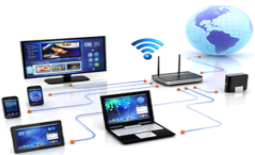Broadband, what is it? by Librarian Nicholas Saturno

Broadband, what is it? by Librarian Nicholas Saturno
What is Broadband?
Broadband Internet service truly is the most used form of Internet access because of its high access speeds; it is offered in four different forms, DSL (or Digital Subscriber Line), also fiber-optic, cable, and satellite. The old dial-up connection is the only non-broadband Internet service available, and even though it is cheaper, most Internet users are moving towards the faster broadband Internet connection.
How does broadband Internet work?
Unlike a dial-up connection, broadband connection uses a dedicated line exclusively for data transmission. DSL internet uses copper phone wires, cable internet uses the same coaxial cable as your television, fiber internet uses specialized fiber-optic cables, and there are wireless options like satellite and 4G/5G LTE.
Each of these types of connections use different frequencies, which provide a range of speeds. A service provider (ISP) uses a network of equipment such as cables, computers, routers, and other devices to connect your home to the internet.
Types of broadband internet.
There are five primary types of broadband connections available today. CenturyLink provides DSL, fiber and 4G/5G, varied by location.
DSL internet
DSL (Digital Subscriber Line) was one of the earliest forms of broadband to be introduced and is still a common service today. DSL uses a single pair of copper wires in a telephone line for high-speed data connection. The DSL signal uses different frequencies from the voice lines, making it possible to use your internet and phone at the same time. Using a modem to bring the connection from your telephone line to your computer allows for DSL to get more “bandwidth,” which increases speeds. DSL speeds can be as high as 100 Mbps.
Fiber Internet
Fiber internet uses a special type of fiber-optic cable, which allows data to be sent as pulses of light over thousands of tiny, transparent fiber strands. Because light is the fastest way to transmit data, fiber-optic internet is incredibly fast, and results in a high-quality and reliable connection. It can provide connections of up to 1 Gbps, and this is expected to get even higher over time. Fiber is an expanding technology that will soon become more widely available.
Cable Internet
Cable internet is about as common as DSL. It uses the same coaxial cables that transmits TV service to carry a high-speed internet connection. Using a modem, you can connect to these cable lines and enjoy a high-speed, uninterrupted data connection. Cable internet speeds can be up to 940 Mbps for downloading and up to 50 Mbps for uploading.
Wireless Internet
Wireless internet is available via satellite. It’s most common in rural areas lacking the infrastructure of wired internet (DSL, cable or fiber) and is typically provided by wireless phone companies.
Satellite
Satellite internet transmits data directly from a satellite orbiting the Earth. It’s not as fast or consistent as other types of broadband internet, but it can be used anywhere in the world. Satellite speeds for downloading are usually between 25 Mbps to 100 Mbps, with an average of 25 Mbps for uploading.
How do I get a broadband internet connection?
Contact Verizon or Cablevision today about high-speed internet service and expanding fiber Internet network and see what speeds are available in your area.
https://www.verizon.com/verizonpartnersolutions/product/broadband-internet/
https://www.optimum.com/internet
You can perform your own free broadband speed test. Follow link https://www.verizon.com/speedtest/
Click Start and see result of your broadband. 100 MB down and 100 MB up is a lower end broadband connection speed. 300 MB and 500 MB are faster speeds, but you will have to pay for it. I personally have 100 MB up/down at my home and it is fine for streaming or downloading movies.

